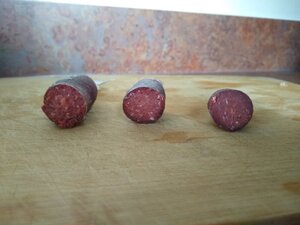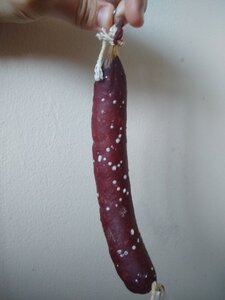Hi, Community!
I am new to this forum and this is actually my first post. I hope I am posting it in the correct place.
I just tried making my first batch of pepperoni and I believe something went wrong in the process. So I would really appreciate some advice from more experienced people.
For my pepperoni, I followed Polcyn and Ruhlman's recipe very closely and got all the quantities correct. I then used hog casing with diameters between 32-36mm (around 1.5”). For the drying process, I hung the pepperoni in a ventilated chamber (it had mini fan on for about half the time) which was constantly around 20 C (68 F) and humidity varying from 75%-90% (it was around 90% in the first days and then 75%-85%). After 7 days, the pepperoni have lost between 38-45% of their weight!
Although I believed they should not be ready, I opened one of them to see what was going on inside (pictures attached). I also tried them (I did not swallowed it though!) for the taste and it did not taste good. It did not taste rotten and it had no bad smell, but it was just not tasty and "normal". I read a bit about case hardening online and think this may be the case, but the pictures I found online seem a bit different than mine.
I am planning on leaving them hanging for another week and see what happens. But by now my hopes are super low.
Any comments would be appreciated. Specially: (1) Is there a way to save them? (2) What could have been the problem?
Thank you very much and have a nice week!
Braga
I am new to this forum and this is actually my first post. I hope I am posting it in the correct place.
I just tried making my first batch of pepperoni and I believe something went wrong in the process. So I would really appreciate some advice from more experienced people.
For my pepperoni, I followed Polcyn and Ruhlman's recipe very closely and got all the quantities correct. I then used hog casing with diameters between 32-36mm (around 1.5”). For the drying process, I hung the pepperoni in a ventilated chamber (it had mini fan on for about half the time) which was constantly around 20 C (68 F) and humidity varying from 75%-90% (it was around 90% in the first days and then 75%-85%). After 7 days, the pepperoni have lost between 38-45% of their weight!
Although I believed they should not be ready, I opened one of them to see what was going on inside (pictures attached). I also tried them (I did not swallowed it though!) for the taste and it did not taste good. It did not taste rotten and it had no bad smell, but it was just not tasty and "normal". I read a bit about case hardening online and think this may be the case, but the pictures I found online seem a bit different than mine.
I am planning on leaving them hanging for another week and see what happens. But by now my hopes are super low.
Any comments would be appreciated. Specially: (1) Is there a way to save them? (2) What could have been the problem?
Thank you very much and have a nice week!
Braga






